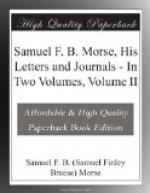“On May 16, 1838, I left the United States and arrived in London in June, for the purpose of obtaining letters patent for my Electro-Magnetic Telegraph System. I learned before I left the United States that Professor Wheatstone and Mr. Cooke, of London, had obtained letters patent in England for a ‘Magnetic-Needle Telegraph,’ based, as the name implies, on the deflection of the magnetic needle. Their telegraph, at that time, required six conductors between the two points of intercommunication for a single instrument at each of the two termini. Their mode of indicating signs for communicating intelligence was by deflecting five magnetic needles in various directions, in such a way as to point to the required letters upon a diamond-shaped dial-plate. It was necessary that the signal should be observed at the instant, or it was lost and vanished forever.
“I applied for letters patent for my system of communicating intelligence at a distance by electricity, differing in all respects from Messrs. Wheatstone and Cooke’s system, invented five years before theirs, and having nothing in common in the whole system but the use of electricity on metallic conductors, for which use no one could obtain an exclusive privilege, since this much had been used for nearly one hundred years. My system is peculiar in the employment of electro-magnetism, or the motive power of electricity, to imprint permanent signs at a distance.
“I made no use of the deflections of the magnetic needle as signs. I required but one conductor between the two termini, or any number of intermediate points of intercommunication. I used paper moved by clockwork upon which I caused a lever moved by magnetism to imprint the letters and words of any required dispatch, having also invented and adapted to telegraph writing a new and peculiar alphabetic character for that purpose, a conventional alphabet, easily acquired and easily made and used by the operator. It is obvious at once, from a simple statement of these facts, that the system of Messrs. Wheatstone and Cooke and my system were wholly unlike each other. As I have just observed, there was nothing in common in the two systems but the use of electricity upon metallic conductors, for which no one could obtain an exclusive privilege.




